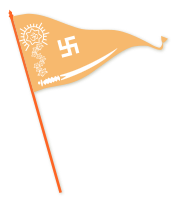Hindu Mahasabha
Appearance
Akhil Bharat Hindu Mahasabha | |
|---|---|
 | |
| Founder | Madan Mohan Malaviya |
| Founded | 1915 (as organization) 1933(as political party)[1] |
| Split from | Indian National Congress[1] |
| Headquarters | New Delhi |
| Ideology | Hindutva[2][3] Hindu nationalism[2][4] Ultranationalism[5][6] Social conservatism[7][8] National conservatism[9] Economic nationalism[10] Right-wing populism[11] |
| Political position | Right-wing[12][13] to far-right[4][14] |
| Colours | Saffron |
| ECI Status | Registered Unrecognised[15] |
| Seats in Lok Sabha | 0 / 543
|
| Seats in Rajya Sabha | 0 / 245
|
| Seats in State Legislative Assembly | 0 / 4,036
|
| Seats in State Legislative Council | 0 / 426
|
| Number of states and union territories in government | 0 / 31
(Collectively 28 States & 3 UTs) |
| Election symbol | |
 [16] [16] | |
| Website | |
| http://www.abhm.org.in/
http://akhilbharathindumahasabha.org/ https://abhmbengal.org.in/ | |
Hindu Mahasabha (officially Akhil Bhārat Hindū Mahāsabhā), All-India Hindu Grand Assembly India ke ek Hindu nationalist political party hae.[2][17][18]
References
[badlo | source ke badlo]- ↑ 1.0 1.1 Ali, Tariq (1985). An Indian Dynasty. G.P. Putnam. p. 196.
- ↑ 2.0 2.1 2.2 Jha 2018, pp. 1–4.
- ↑ Bapu 2013, p. 61.
- ↑ 4.0 4.1 Six, Clemens (2017). Secularism, Decolonisation, and the Cold War in South and Southeast Asia. Routledge. "The Hindu Mahasabha, a far-right Hindu nationalist political party"
- ↑ Bingham, Woodbridge (1974). A History of Asia. Allyn and Bacon. p. 601.
- ↑ Hauner, Milan (1981). India in Axis strategy. Klett-Cotta. p. 66.
- ↑ Jaffrelot, Christophe (2010). Religion, Caste, and Politics in India. Primus Books. p. 63.
- ↑ Cush, Denise (2012). Encyclopedia of Hinduism. Routledge. p. 316.
- ↑ Misra, Amalendu (1999). "Savarkar and the Discourse on Islam in Pre-Independent India". Journal of Asian History 33 (2): 175.
- ↑ Chatterjee, Nirmal C. (1959). Hindu Mahasabha Tracts. Vedic Press. p. 12.
- ↑ Tamadonfar, Mehran (2013). Religion and Regimes. Lexington Books. p. 125.
- ↑ Delap, L (2013). Men, Masculinities and Religious Change in Twentieth-Century Britain. Springer. p. 152.
- ↑ Kumaraswamy, P.R. (2010). India's Israel Policy. Columbia University Press. p. 159.
- ↑ Luce, Henry Robinson (17 October 1949). "INDIA: Anchor for Asia". Time. Vol. 54. Time Incorporated. p. 33.
- ↑ "Archived copy" (PDF). Archived from the original (PDF) on 30 May 2018. Retrieved 29 May 2018.CS1 maint: archived copy as title (link)
- ↑ Vikram Doctor. "Congress: History of election symbols: How they still help to connect with the masses", 18 November 2013. “Other parties were happier with what they got – the Hindu Mahasabha had a suitably aggressive horse and rider..”
- ↑ McDermott, Rachel Fell; Gordon, Leonard A.; Embree, Ainslie T.; Pritchett, Frances W.; Dalton, Dennis (2014). Sources of Indian Traditions: Modern India, Pakistan, and Bangladesh. Columbia University Press. pp. 439–. ISBN 978-0-231-51092-9. https://books.google.com/books?id=w8qJAwAAQBAJ&pg=PA439.
- ↑ Klostermaier, Klaus K. (1989). A Survey of Hinduism: First Edition. SUNY Press. pp. 403–. ISBN 978-0-88706-807-2. https://books.google.com/books?id=ltn3OuF_i4sC&pg=PA403.
